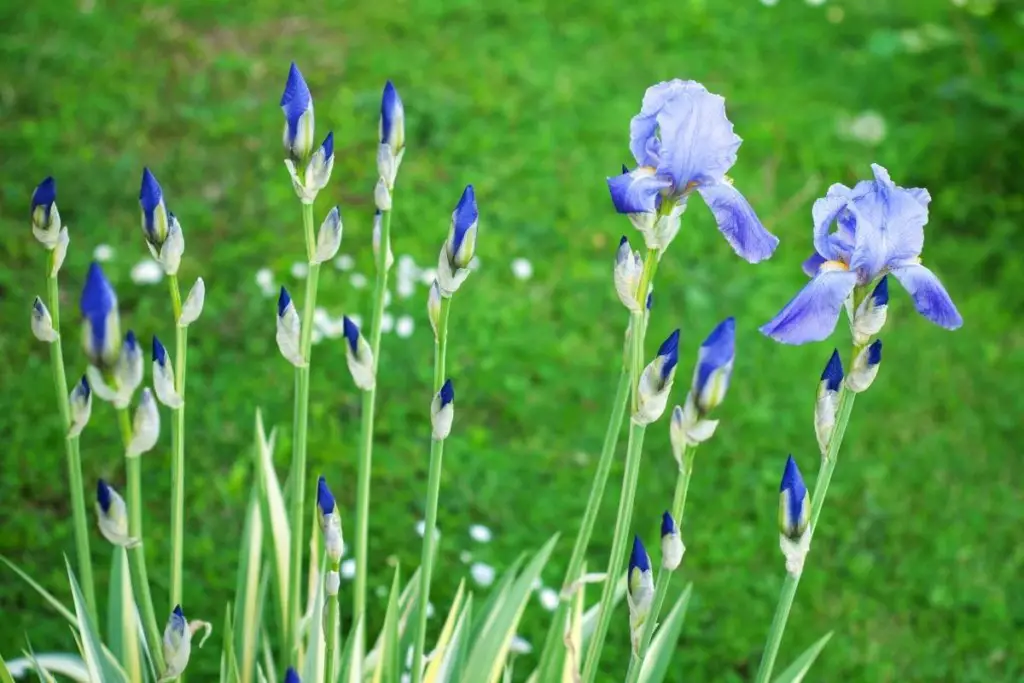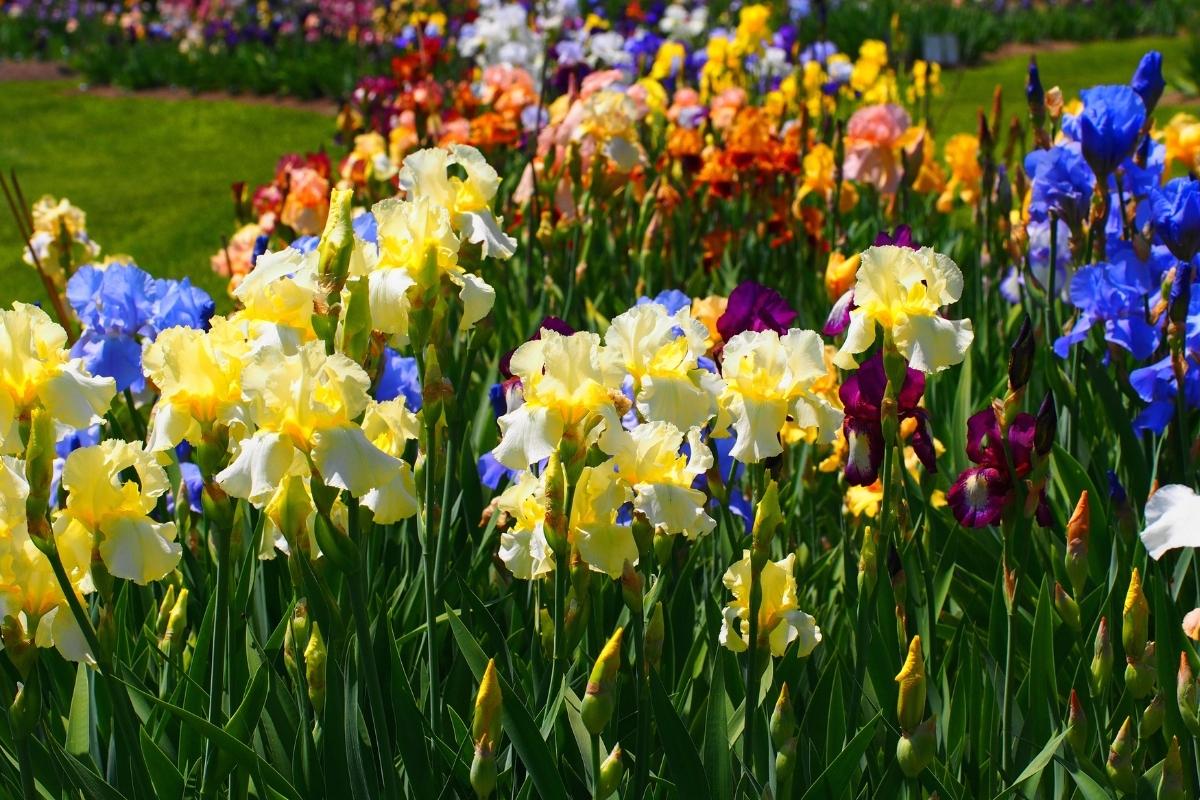In this guide, you’ll have the opportunity to learn how to grow Iris. When properly grown and cared for, it’s not hard for this plant to survive for up to two decades. You’ll have the opportunity to learn all about the tips and tricks for properly caring for Iris as it grows. You’ll also get the chance to learn about the types of environments and conditions that are most ideal for this specific plant.
Table of Contents
Growing Iris
Anyone can grow Iris in their garden easily after learning the basic tips and tricks for doing so. They are ideally grown in the later portions of the summertime and need to be planted in well-drained soil. They thrive in conditions that include heavy sunlight for more than eight hours per day.
Irises are also tolerant towards moderate sunlight conditions and partial shade for a few hours per day.
Having a garden full of thriving Iris plants is a great vision to have, but it takes some understanding of the ideal conditions and maintenance that this plant species requires. They are tolerant and capable of growing fairly quickly, but there are some important tips that you should always follow when preparing to grow Iris.
Iris is a perennial flower and plant.
Iris Needs To Be Exposed To Full Sunlight
They should ideally be planted during June, July, or August. It needs to be planted in a location that allows for full sunlight to reach the Iris plant for the majority of the day. The root system will develop and improve during these months to be prepared for the remaining seasons throughout the year.
There is a significant sizing difference between Iris flowers, especially if you consider the fact that some can grow to be only a single foot tall while others can grow more than four feet.
The height of the Iris flower can depend on where it is planted, soil conditions, and how well-established the root system becomes during the late summertime.
Tips for Growing Iris
Growing Irises can be easy as long as you keep a few best practices in mind for the growing season. Since irises are perennial flowers, they can be kept for many years with proper care. Here are some tips and tricks on how to keep irises in top shape.
Iris care tips:
- Plant your new rhizomes in August or September. New iris rhizomes should be planted in the fall around August or September.
- Prune irises in the fall. Pruning irises in the fall is a good habit. This will help them grow back healthier the next season.
- Divide your irises. You should always make a habit of divided irises at least once a year, so they will live a long life.
- Plant them with plenty of room to breathe. Irises do not do well if other plants are blocking their light. Give them room to breathe.
- Give them a bed of their own. Because they do not do well with plants blocking light, it is better to give them a plant bed of their own.
- Loosen the soil with a tiller. Iris grows best in soil that is loose. Use a hand tiller to till up the soil in the bed.
- Make sure they have proper drainage. Irises need to have a good drainage system set up, of rocks and sand. They must not get too wet.
- Keep Rhizomes exposed. You need to keep the rhizomes exposed so that they can get a little bit of sunlight and air.
- Deadhead irises consistently. You should remove the spent blooms so that they can bud along the stems.
Iris care can be rewarding. They are beautiful flowers that will bring you many years of joy. All you have to do is make sure that they are well taken care of, given the right conditions, where they can get plenty of sunlight. The best part about dividing irises is that you get to give them away to your friends. Source.
Different Types of Iris Flowers
Alright, so now it’s time to discuss some of the more confusing terms that come with Iris flowers. What are ‘bulbous’ irises and why are they different from ‘rhizomatous’ irises?
Rhizomatous Iris
These types of Iris can grow into bearded variations of the flower, which means that they have a slightly different appearance. The visual difference mostly comes from the bushy lower petals that are seen on the blossom. These variations are commonly found in Europe while the beardless ones are more commonly found across Asia.
Bulbous Iris
These are smaller variations, also known as ‘dwarf irises’. They can bloom more quickly than the ‘rhizomatous’ irises in many circumstances. They are not as common but can be used for various gardening purposes.
Iris Description | What Do Irises Look Like?
Iris flowers come in many shades. They can be white, lavender, purple, yellow, pink, and almost black. The bearded iris can get 18’’ to 36’ tall. Dwarf irises can be as small as 6 inches, with yellow flag irises getting 5’ tall. They have six petals. The three inner true petals are known as ‘standards’, while the three outer petals are called ‘falls.’ Source.

How Much Water Does Iris Need To Grow Properly?
One of the really nice things that you’ll quickly learn about Iris is that it doesn’t need a whole lot of water maintenance. You should only need to water this type of plant once per week to ensure it doesn’t get too dry.
Even if the Iris gets unusually dry, a little bit of extra water won’t hurt it. The Iris should never be exposed to standing water for extended periods. Well-drained soil is important in addition to the water requirements.
Maintaining Iris | Best Tips and Tricks
Let’s spend a little bit of time talking about the various maintenance requirements for properly taking care of Iris. You should try to keep the flower’s foliage in optimal condition when cutting. The flowering stalks can be cut back but it’s important to not harm the foliage because this is where crucial energy is held for the future.
For ‘rhizomatous’ Iris to survive for twenty years, it should be divided approximately every four years around the late-summer time. This is an important tip if you plan on having your Iris flowers thrive for longer periods.
Related Questions
Can Iris survive and grow in shady conditions?
Not ideally, while Iris flowers may be able to survive, they won’t grow anywhere near their full potential and may struggle to achieve optimal growing expectations if not enough sunlight reaches them.
Which months are best for planting and growing Iris?
Around June or July is probably the best time to plant Iris. In some situations, it can even be ideal to plant iris flowers in September or October, depending on weather projections and local temperatures.

